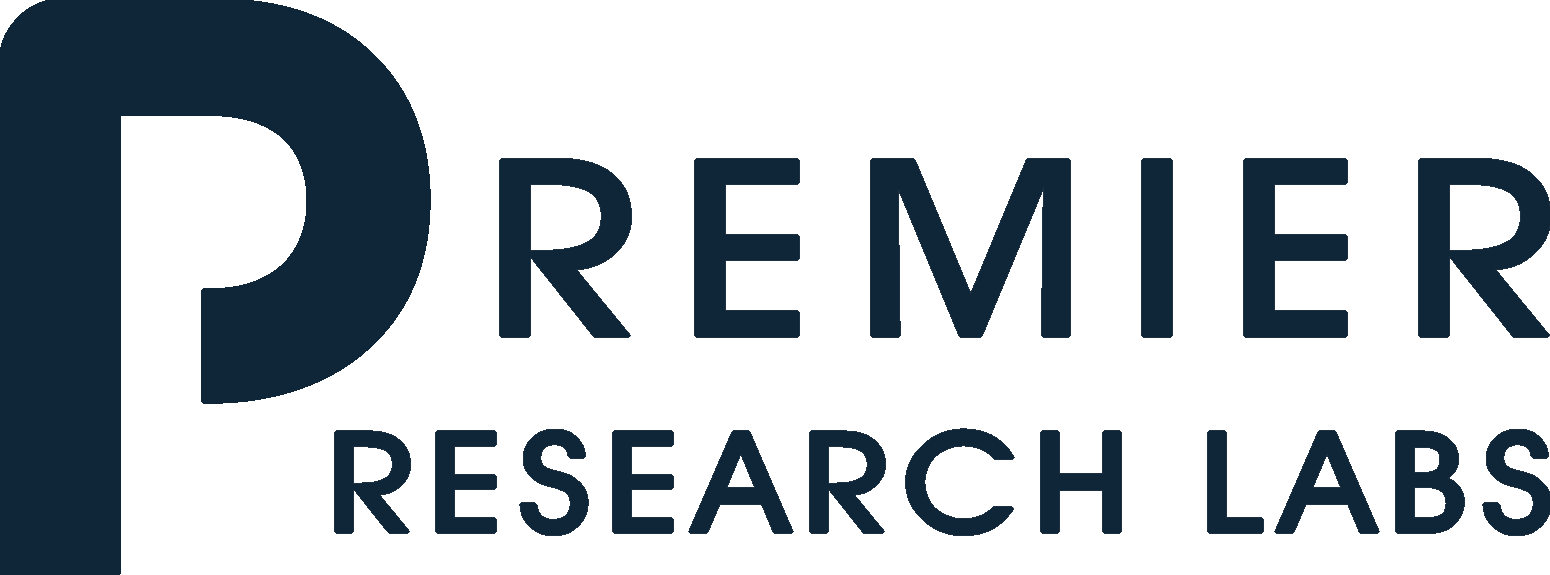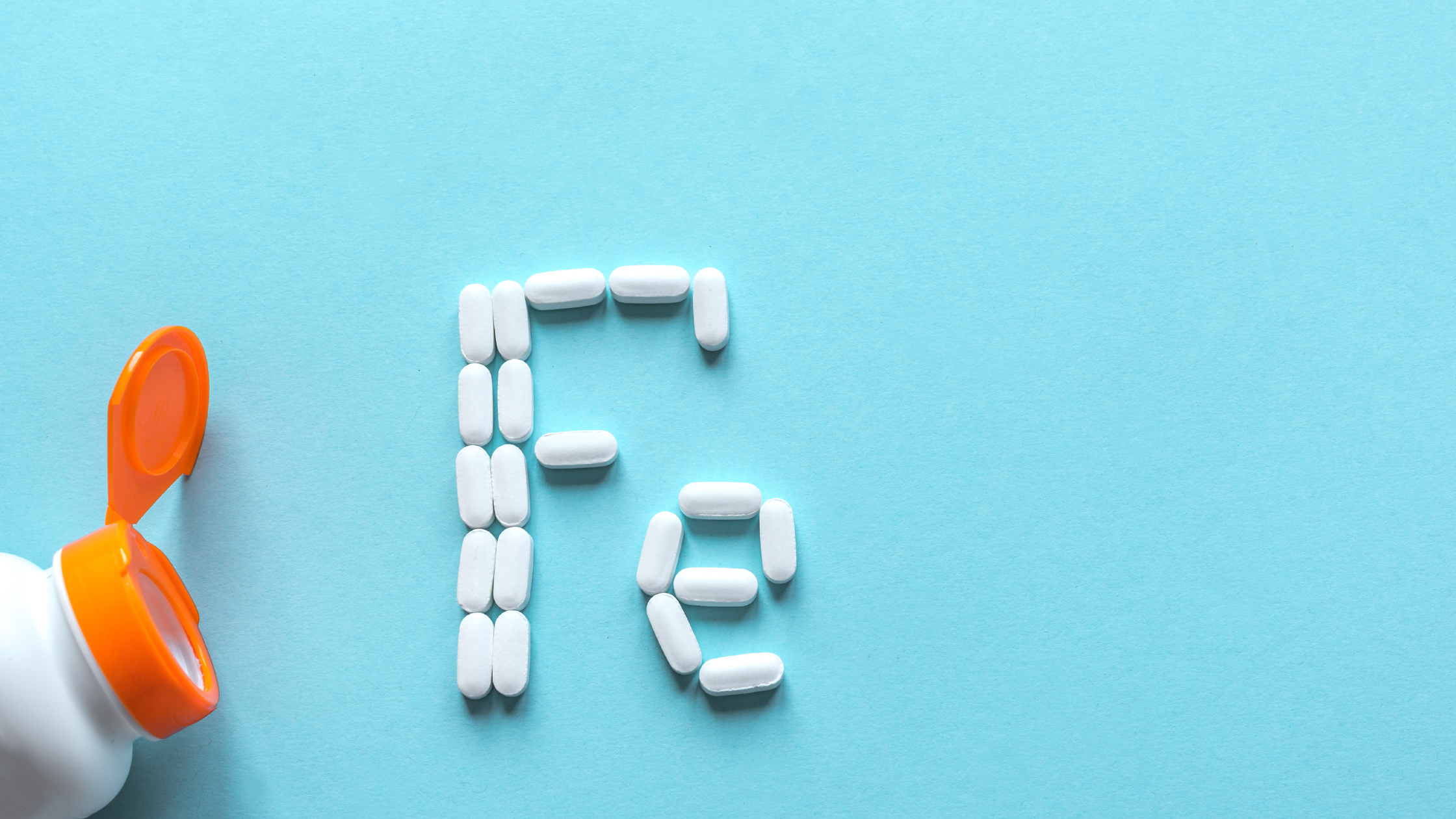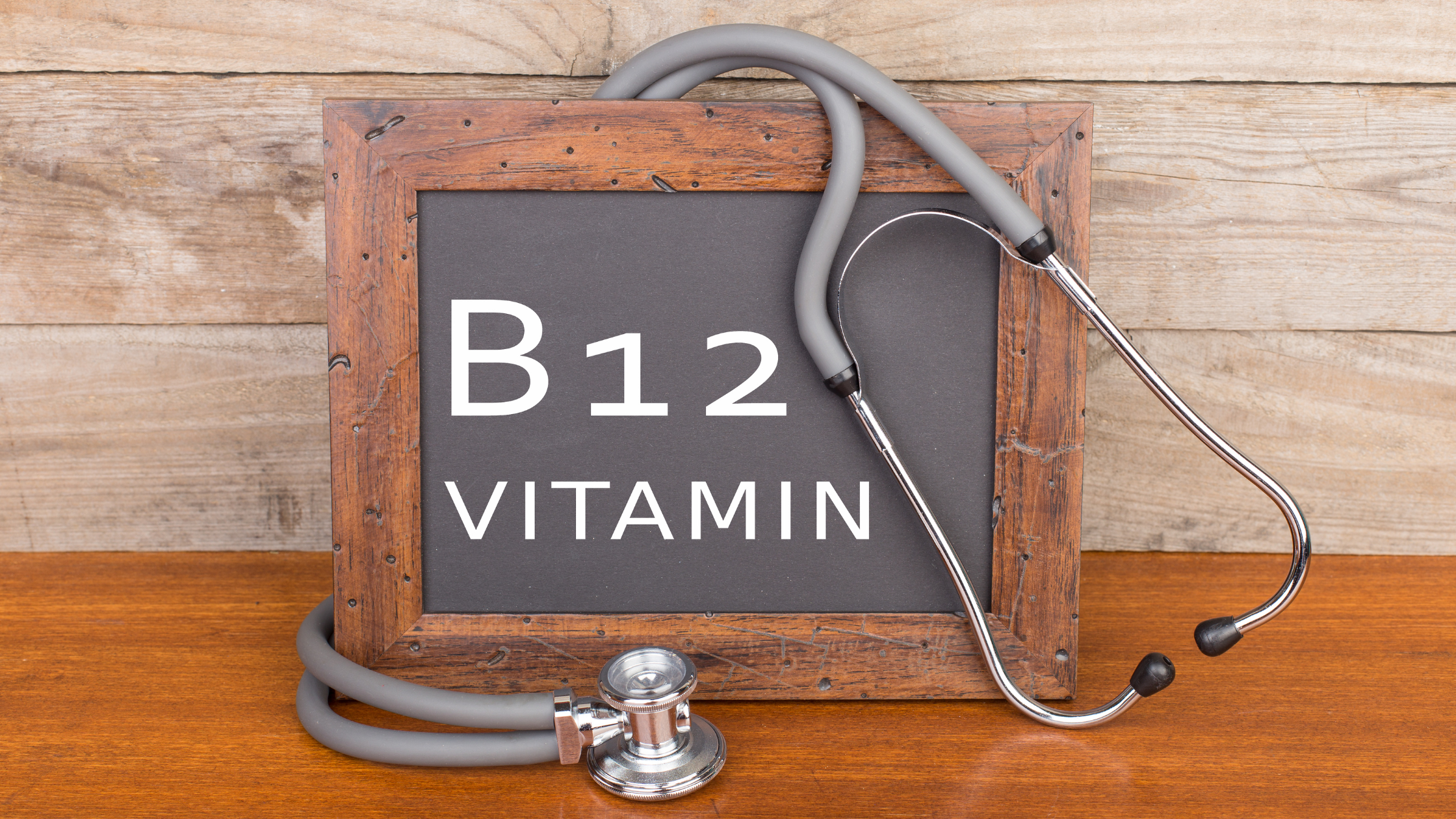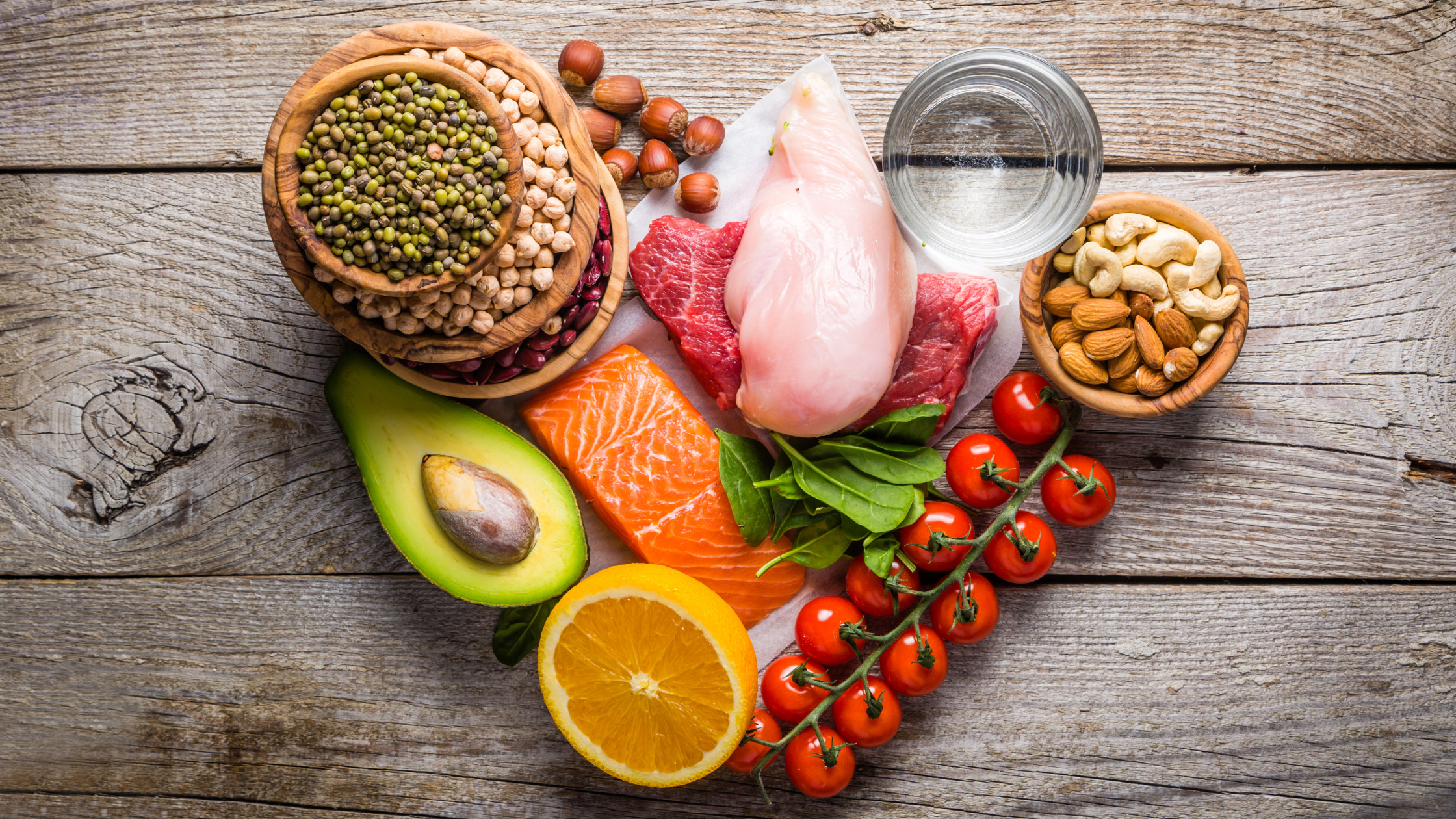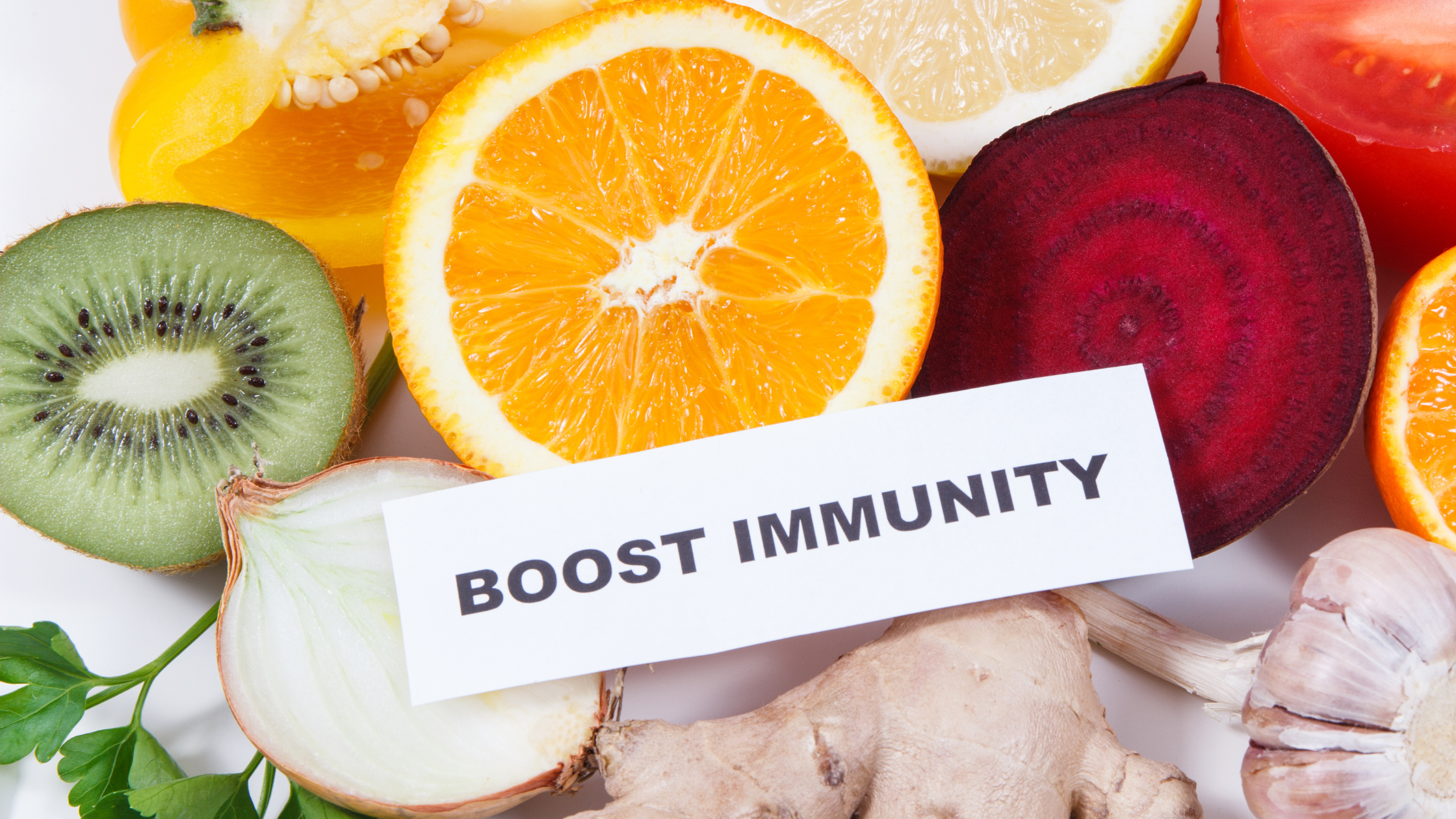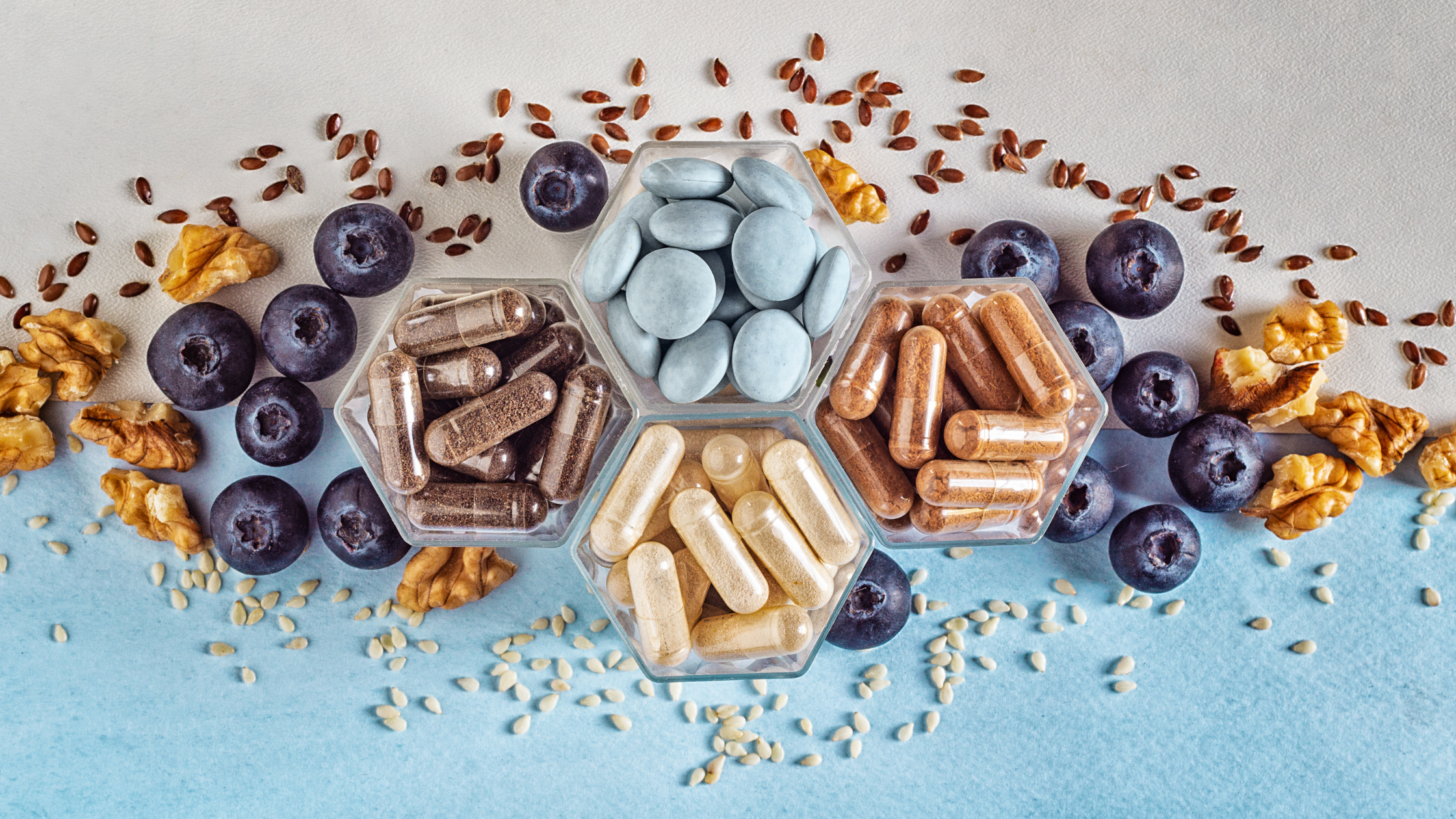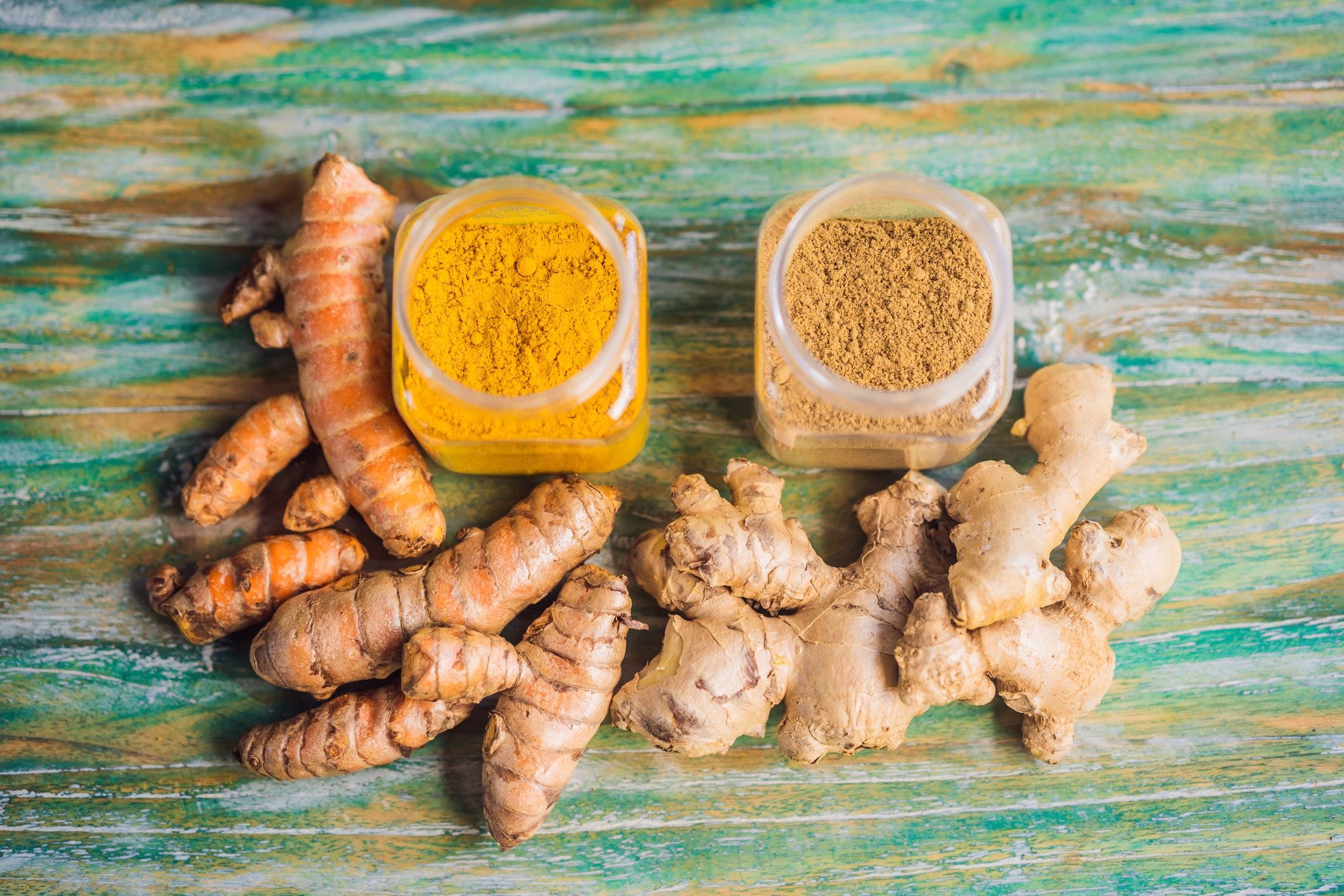
Create a Harmonic Herbal Fusion with Turmeric and Ginger
Herbal synergy is an integral part of holistic medicine. The theory behind this idea is that by combining certain botanical compounds, we see a more powerful effect when compared with administering each individual compound on its own. A compelling demonstration of herbal synergy can be found in a deceptively humble pairing: turmeric (Curcuma longa) and ginger (Zingiber officinale).
Turmeric and ginger are notable companions due to their shared functions in the body, including targeting inflammation and free radicals, as well as their overlapping cellular signaling pathways.1 These vibrant substances work together to stoke the body’s inner radiance by supporting the immune system, nurturing healthy digestion, and reducing inflammation.2
We delve into the complex bioactive compounds contained within turmeric and ginger, how fermentation improves the body’s ability to absorb them, and how you can help your clients combat capsule fatigue with creative methods for consuming them.
Benefits of Turmeric and Ginger
Turmeric is a bright yellow spice harvested from the rhizome of the turmeric (Curcuma longa) plant. Turmeric’s use in medicine dates back thousands of years to India and China, where it has been relied upon to treat a variety of diseases.3 Although clinical research is in its early stages, turmeric is currently under investigation as a potential treatment for inflammatory conditions and certain types of cancer.4
Ginger (Zingiber officinale) is another rhizome within the same family as turmeric (Zingiberaceae) and with a similar history, having been used for many centuries across ancient cultures to manage health issues like nausea and diarrhea. This practice continues today, with many health care providers recommending ginger products to treat upset stomach, nausea and vomiting, and migraines.5
Recent studies by Zhou, Xian et al (2022) found synergistic inflammatory effects on human cells when ginger and turmeric were combined.1,2 The researchers noted that the combination acted more effectively against proinflammatory cytokines while reducing cytotoxicity when compared to turmeric or ginger administered on their own. The variety of active phytonutrients within turmeric and ginger underlies these powerful reactions.
Amazing Antioxidants
The connection between oxidative stress, inflammation, and chronic disease is well-documented.6 Antioxidants promote healthy aging and serve as the body’s defense against oxidative stress by reacting with and changing the molecular structure of free radicals, thereby terminating their damaging chain reactions.7
Turmeric and ginger both possess potent antioxidant compounds. Turmeric’s main antioxidant is curcumin. Curcumin binds, or chelates, pro-oxidant metals, interferes with the production of reactive oxygen species (ROS), and neutralizes free radicals.8 It also suppresses advanced glycation end products (AGEs) and lipid peroxidation, both of which also contribute to oxidative cellular damage.8,9,10
Antioxidant compounds found in ginger include gingerols, shogaols, flavonoids, and phenolic acids. Numerous clinical studies have demonstrated the antioxidant activity of ginger supplements and their ability to decrease free radical levels and moderate the production of nitric oxide, high levels of which can contribute to cellular DNA damage.8
Inflammation Interceptors
Turmeric and ginger also have the power to address overactive inflammatory responses in the body, which are also related to oxidative stress and have been shown to underly numerous chronic and autoimmune conditions.8 Taking steps to address inflammation before it becomes chronic is an essential part of maintaining optimal health and wellness.
A meta-analysis of turmeric supplementation trials showed that turmeric reduced levels of multiple inflammatory markers: tumor necrosis factor alpha (TNF-α), monocyte chemoattractant protein-1 (MCP-1), interleukin (IL)-6, IL-8, and c-reactive protein (CRP).11
Evidence suggests that ginger supplementation also reduces levels of IL-6, CRP, and TNF-α. Bioactive compounds in ginger called 6-gingerol and 6-shogaol have particularly robust anti-inflammatory effects by blocking the production of PGE2 and proinflammatory cytokines including cyclooxygenase-2 (COX-2).8
Additional Benefits
Laboratory studies on turmeric and ginger have found additional health- and longevity-promoting cellular activity, including those outlined in the table below.8
Table 1: Overview of the Health Benefits of Turmeric and Ginger
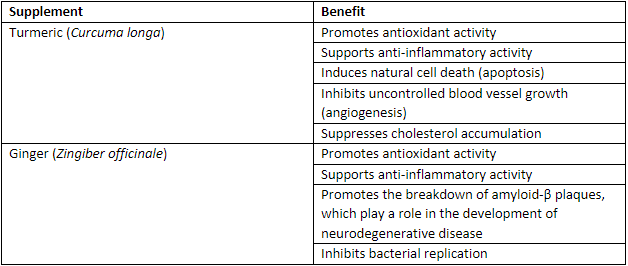
Fermentation for Optimal Bioavailability
Fermentation is a method of breaking down plant compounds before consumption to enhance their digestibility and promote a healthy gut microbiome. Fermentation is sometimes described as “pre-digestion” because the bacteria, yeast, or other microbes begin to break down the food in the same way the digestive system does. By initiating this process before the product is consumed, the body spends less energy breaking down the substance and can more easily utilize its component parts.12 The fermentation of turmeric and ginger improves the extent to which the body is able to use the phytochemicals contained in these medicinal spices.
In addition to making foods more digestible, fermentation creates new healthful compounds and introduces beneficial probiotics to the digestive system. A growing body of research indicates that the microflora making up the digestive system affects numerous other aspects of health, including immunity, weight, and mood.13,14 Probiotics are live microorganisms, such as specific strains of bacteria and yeast, that support a balanced gut microbiome.
When considering turmeric and ginger supplementation options for your clients, keep in mind that fermented turmeric and ginger is formulated to be easily and efficiently used by the body and provides essential, gut-supporting probiotics.
Fight Capsule Fatigue
Capsule fatigue or capsule burden refers to when clients lose motivation to take their daily supplements because they are overwhelmed by the number of capsules or by the frequency with which they are being asked to take them. Capsule fatigue can cause non-compliance to the prescribed regimen, which has the potential to harm both the client’s health and their relationship with their practitioner.
You can help your clients access the potent antioxidant and anti-inflammatory compounds in turmeric and ginger without adding to their capsule burden by suggesting a powdered formulation that allows them to consume this supplement in an alternative way. Phytochemical-delivering golden milk, gut flora-supporting miso soup, collagen-boosting bone broth, or a simple brewed tea are all options that amplify the synergistic benefits of fermented turmeric and ginger.
Golden Milk
Golden milk, also known as a turmeric latte, is a milk and turmeric drink that has gained consumer popularity in recent years and is utilized as a delicious vehicle to deliver the array of beneficial compounds that its ingredients have to offer. Golden milk has roots in the medicine system of India known as Ayurveda and is often enjoyed as a delicious daily tonic.
Turmeric and its famous active constituent, curcumin, can be difficult to absorb and require fairly large amounts of turmeric (3 to 5 grams), the help of synergistic herbs such as black pepper (Piper nigrum), as well as a healthy fat source (like milk, ghee or a non-dairy alternative) to efficiently quell inflammation. A recent investigation found that adding turmeric to milk increases its antioxidant effects.15 The pungent spices included in golden milk help to improve digestion and boost inner radiance by channeling glow and luster to the skin.
Encourage your clients who may be experiencing capsule fatigue to try integrating medicinal spices including turmeric and ginger using the golden milk recipe below:
Golden Spice Blend Recipe
- 4 tablespoon ground turmeric
- 2 teaspoon ground ginger (alternatively, substitute 3 scoops of fermented turmeric/ginger powder for turmeric AND ginger)
- 1 tablespoon cinnamon
- 1/2 teaspoon ground black pepper
- 1/8 teaspoon ground nutmeg (optional)
- 1/8 teaspoon ground clove (optional)
- 1/2 teaspoon cardamon (optional)
Golden Milk Recipe
- 1 heaped teaspoon Golden Spice Blend (recipe above)
- 2 teaspoon maple syrup
- 2 teaspoon hot water
- 1 cup dairy-free milk
Mix Golden Spice Blend ingredients in a small jar or container and shake to mix thoroughly. This mixture can be stored for up to 3 months in an airtight container. Combine 1 heaped teaspoon Golden Spice Blend and hot water in a small saucepan. Add milk, stir, and warm over medium heat until the mixture reaches your desired temperature for drinking. Optionally, use a milk frother or blender to create a frothy texture.
Miso Soup
Miso is a fermented soybean paste that includes rice, wheat, or barley and salt. It has been a nutritional staple since at least 600 A.D. in China.16 Miso is reported to alleviate intestinal inflammation and possesses metabolism-modulating, blood pressure-regulating, and oxidative stress-fighting properties.16 These characteristics make it a perfect foundation for delivering turmeric and ginger.
Try the following recipe for a luscious, savory miso soup:
- 1 cup vegetable broth
- 1 tablespoon miso paste
- 1½ teaspoon turmeric
- 1/2 teaspoon ground ginger (alternatively, substitute 1 scoop of fermented turmeric/ginger powder for ginger AND turmeric)
- Tofu, seaweed, dashi, and/or green onion to taste (optional)
Bring broth to boil in a saucepan and reduce heat to medium. Stir in miso paste, powdered turmeric and ginger, and any optional additions you choose. Simmer gently for 3 minutes before removing from heat.
Bone Broth
Bone broth is made by simmering animal bones for many hours to extract collagen and other nutrients from the bones. Bone broth is an excellent source of collagen, which makes up around 25% of the protein in the body and contributes to the strength and elasticity of the skin, muscles, and other connective tissues.17 Bone broth also possesses antioxidant and anti-inflammatory properties by inhibiting COX-2 activity.18
Bone broth can be purchased from the store, but quality and nutritional depth varies. We suggest making your own and incorporating turmeric and ginger by following this tried-and-true recipe:
- 3 pounds of organic, grass-fed animal bones (beef, poultry, lamb, or venison)
- 2 cups of vegetables, such as carrots, onion, and celery
- 4 cloves of garlic
- 2 tablespoons of apple cider vinegar
- 4 tablespoon ground turmeric
- 2 teaspoon ground ginger (alternatively, substitute 3 scoops of fermented turmeric/ginger powder for turmeric AND ginger)
- Pink salt and black pepper
- Other seasonings, such as bay leaves, start anise, and cinnamon (optional)
- 8 cups of water
Preheat oven to 425 degrees. Place bones in a deep roasting pan, sprinkle with salt, and roast for 30 minutes. Combine bones, vegetables and garlic, apple cider vinegar, turmeric and ginger, other seasonings, and water in a large stock pot over high heat and bring to a boil. Reduce heat, cover, and simmer for at least 6 hours or up to 24 hours. The longer you simmer, the more collagen is extracted and the more flavorful the bone broth will be.
References
- Zhou, Xian et al. “Synergistic anti-inflammatory activity of ginger and turmeric extracts in inhibiting lipopolysaccharide and interferon-γ-induced proinflammatory mediators.” Molecules, vol. 27, no. 12, 2022, https://www.ncbi.nlm.nih.gov/pmc/articles/PMC9229778/.
- Zhou, Xian et al. “Synergistic inhibition of pro-inflammatory pathways by ginger and turmeric extracts in RAW 264.7 cells.” Frontiers in Pharmacology, vol. 13, 2022, https://www.ncbi.nlm.nih.gov/pmc/articles/PMC9160922/.
- Prasad, Sahdeo, and Bharat B. Aggarwal. “Turmeric, the golden spice: From traditional medicine to modern medicine.” Herbal Medicine: Biomolecular and Clinical Aspects, 2nd ed., CRC Press/Taylor & Francis, 2011. National Library of Medicine, https://www.ncbi.nlm.nih.gov/books/NBK92752/.
- Hatcher, H et al. “Curcumin: From ancient medicine to current clinical trials.” Cellular and Molecular Life Sciences, vol. 65, no. 11, 2008, pp. 1631-52, https://www.ncbi.nlm.nih.gov/pmc/articles/PMC4686230/.
- About Herbs, Botanicals & Other Products. “Ginger: Purported benefits, side effects & more.” Memorial Sloan Kettering Cancer Center, 2023, https://www.mskcc.org/cancer-care/integrative-medicine/herbs/ginger. Accessed January 11, 2024.
- Pizzino, Gabriele et al. “Oxidative stress: Harms and benefits for human health.” Oxidative Medicine and Cellular Longevity, vol. 2017, 2017, https://www.ncbi.nlm.nih.gov/pmc/articles/PMC5551541/.
- Janciauskiene, Sabina. “The beneficial effects of antioxidants in health and diseases.” Chronic Obstructive Pulmonary Diseases, vol. 7, no. 3, 2020, pp. 182-202, https://www.ncbi.nlm.nih.gov/pmc/articles/PMC7857719/.
- Ballester, Pura et al. “Antioxidant activity in extracts from Zingiberaceae family: Cardamom, turmeric, and ginger.” Molecules, vol. 28, no. 10, 2023, https://www.ncbi.nlm.nih.gov/pmc/articles/PMC10220638/.
- Goldin, Alison et al. “Advanced glycation end products: Sparking the development of diabetic vascular injury.” Circulation, vol. 114, no. 6, 2006, pp. 597-605, https://www.ahajournals.org/doi/full/10.1161/CIRCULATIONAHA.106.621854.
- Nam, Tae-Gyu. “Lipid peroxidation and its toxicological implications.” Toxicological Research, vol. 27, no. 1, 2011, pp. 1-6, https://www.ncbi.nlm.nih.gov/pmc/articles/PMC3834518/.
- Ferguson, Jessica J. A. et al. “Anti-inflammatory effects of oral supplementation with curcumin: A systematic review and meta-analysis of randomized controlled trials.” Nutrition Reviews, vol. 79, no. 9, 2021, pp. 1043-1066, https://academic.oup.com/nutritionreviews/article/79/9/1043/6019950.
- Dimidi, Eirini et al. “Fermented foods: Definitions and characteristics, impact on the gut microbiota and effects on gastrointestinal health and disease.” Nutrients, vol. 11, no. 8, 2019, https://www.ncbi.nlm.nih.gov/pmc/articles/PMC6723656/.
- Zhang, Yu-Jie et al. “Impacts of gut bacteria on human health and diseases.” International Journal of Molecular Sciences, vol. 16, no. 4m, 2015, https://www.ncbi.nlm.nih.gov/pmc/articles/PMC4425030/.
- American Heart Association News. “How bacteria in your gut interact with the mind and body.” American Heart Association, 2020, https://www.heart.org/en/news/2020/05/28/how-bacteria-in-your-gut-interact-with-the-mind-and-body. Accessed January 11, 2024.
- Idowu-Adebayo, Folake et al. “Turmeric-fortified cow and soya milk: Golden milk as a street food to support consumer health.” Foods, vol. 11, no. 4, 2022, https://www.ncbi.nlm.nih.gov/pmc/articles/PMC8871262/.
- Saeed, Farhan et al. “Miso: A traditional, nutritious & health-endorsing fermented product.” Food Science & Nutrition, vol. 10, no. 12, 2022, pp. 4103-11, https://www.ncbi.nlm.nih.gov/pmc/articles/PMC9731531/.
- Shenoy, Mahesh et al. “Collagen structure, synthesis, and its applications: A systematic review.” Cureus, vol. 14, no. 5, 2022, https://www.ncbi.nlm.nih.gov/pmc/articles/PMC9177216/.
- Peterson, Orion J et al. “Neuroprotective effect of enriched chicken bone broth as a dietary supplement in a model of migraine mediated by early life stress.” Journal of Medicinal Food, vol. 23, no. 12, 2020, pp. 1259-1265. https://www.ncbi.nlm.nih.gov/pmc/articles/PMC7864107/.
